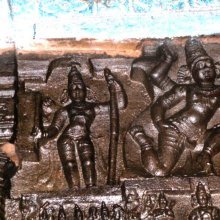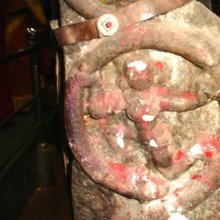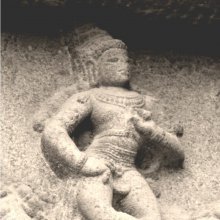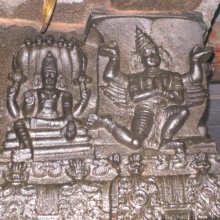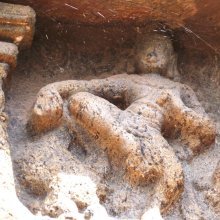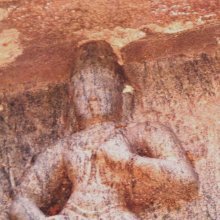Kuncita, Kuñcita, Kuñcitā, Kumcita: 20 definitions
Introduction:
Kuncita means something in Hinduism, Sanskrit, Buddhism, Pali. If you want to know the exact meaning, history, etymology or English translation of this term then check out the descriptions on this page. Add your comment or reference to a book if you want to contribute to this summary article.
Alternative spellings of this word include Kunchita.
Images (photo gallery)
(+46 more images available)
In Hinduism
Natyashastra (theatrics and dramaturgy)
Source: Wisdom Library: Nāṭya-śāstra1a) Kuñcita (कुञ्चित, “contracted”).—One of the 108 karaṇas (minor dance movement) mentioned in the Nāṭyaśāstra chapter 4. The instructions for this kuñcita-karaṇa is as follows, “a leg to be first Añcita and left hand to be held on the left side with its palm upwards.”. A karaṇa represents a minor dance movements and combines sthāna (standing position), cārī (foot and leg movement) and nṛttahasta (hands in dancing position).
1b) A specific gesture (āṅgika) made with the eyelids (puṭa), according to the Nāṭyaśāstra chapter 8. These gestures of the eyelids (puṭa) are supposed to follow the corresponding movements of the eyeballs (tārā). These gestures form a part of the histrionic representation (abhinaya).
(Instructions): contracting the eyelids. (Uses): in seeing undesired objects. sweet scent (gandha), flavour (rasa) and touch (sparśa).
1c) A specific gesture (āṅgika) made with the eyebrows (bhrū), according to the Nāṭyaśāstra chapter 8. These gestures of the eyelids (puṭa) are supposed to be performed in accordance with the corresponding gestures of the eyeballs (tārā) and the eyelids (puṭa). These gestures form a part of the histrionic representation (abhinaya).
(Instructions): slightly bending of eyebrows one by one or the both at once. (Uses): in manifestation of affection (moṭṭāyita), pretended anger (kuṭṭamita) and hysterical mood (kilakiñcita).
1d) A specific gesture (āṅgika) made with the cheeks (kapola or gaṇḍa), according to the Nāṭyaśāstra chapter 8. These gestures form a part of the histrionic representation (abhinaya).
(Instructions): (cheeks are) narrowed down. (Uses): in horripilation (sensitive) touch, cold, fear and fever.
1e) A specific gesture (āṅgika) , or “movements made with the arms (bāhu)”, according to the Nāṭyaśāstra chapter 9. These movements form a part of the histrionic representation (abhinaya).
1f) A specific ‘movement of the feet’ (pāda), according to the Nāṭyaśāstra chapter 10. The feet are one of the six major limbs (aṅga) used to perform certain gestures (āṅgika). These gestures form a part of the histrionic representation (abhinaya).
(Instructions): the heels thrown up, toes all bent down and the middle of the feet too bent. (Uses): It is to be used in aristocratic (udātta) gait, turning, round to the right and vice versa and in the Atikrāntā Cārī.
2a) Kuñcitā (कुञ्चिता, “contracted”) refers to a specific “glance” (dṛṣṭi), according to the Nāṭyaśāstra chapter 8. This is a type of glance that expresses a ‘transitory state’ (saṃcāribhāva). There are a total thirty-six glances defined.
(Instructions): The Glance in which ends of eyelashes are bent due to the eyelids being contracted and the eyeballs are also contracted, is called Kuñcitā (contracted). (Uses): in envy, undesirable object, objects visible with difficulty and pain in the eye.
2b) A specific gesture (āṅgika) made with the neck (grīvā), according to the Nāṭyaśāstra chapter 8. These ‘gestures of the neck (grīvā)’ should follow the gestures made with the head (śiras). These gestures form a part of the histrionic representation (abhinaya).
(Instructions): the neck with the head turned back. (Uses): in pressure of weight and in protecting the neck.
Source: archive.org: The mirror of gesture (abhinaya-darpana)1) A type of glance (or facial expression): Kuñcita (curved): the lashes a little recurved, the eyeballs a little sunk; dislike, or jealousy.
2) One of six movements of the Brows: Kuñcita: one or both brows arched. Usage: rapture at being reminded of an absent lover (moṭṭayita), feigned anger (kuṭṭamita), pleasure at seeing the beloved (vilāsa), hysterics (kilakiñcita)
3) One of the hasta-prāṇa, or ‘Twelve Lives of the Hands’: Kuñcita (bent, inclined): bending the fingers
Source: archive.org: Illustrations of Indian Music and Dance in Western Indian Style (natya)Kuñcita (कुञ्चित) refers to “bending the eye-bows, one or both”, and is classified as one of the seven movements of the eye-brows, which forms a part of upāṅga (minor body-parts) in Nāṭyaśāstra. Kuñcita can be used in eagerness, even though much pleased, pretending to be otherwise, the charm in the woman, smiling, laughter, crying, sadness, pride, ambition, and fatigue.
Source: Shodhganga: The significance of the mūla-beras (natya)Kuñcita means “heels thrown down, toes all bent down” and represents one of five actions of the foot used in kūttu (dance) as defined in the first book of the Pañcamarapu (‘five-fold traditional usage’) which deals with niruttam (dance, one of the sixty–four arts) and represents an important piece of Tamil literature.—The Pañcamarapu (“five-fold traditional usage”) refers to a book on five established literary usages (five-fold traditional usages) defines terms such as Kuñcita. It was composed by Cerai Aṟivanār in the 9th century AD during the time of Pandyan Tirumaran of the last Caṅkam Period.
Source: Shodhganga: Elements of Art and Architecture in the Trtiyakhanda of the Visnudharmottarapurana (natya)1) Kuñcita (कुञ्चित) refers to one of the 108 kinds of Karaṇa (“coordination of precise movements of legs and hands”), according to the Viṣṇudharmottarapurāṇa, an ancient Sanskrit text which (being encyclopedic in nature) deals with a variety of cultural topics such as arts, architecture, music, grammar and astronomy.—According to the Viṣṇudharmottarapurāṇa, karaṇas are the coordination of precise movements of legs and hands performed in a particular posture. The Nāṭyaśāstra also gives its view point in the same spirit. In the Viṣṇudharmottarapurāṇa, one hundred and eight kinds of karaṇas are accepted, e.g., Kuñcita.
2)Kuñcitā (कुञ्चिता) refers to one of the Thirty six kinds of Glances (dṛṣṭi) or “proper accomplishment of glances” (in Indian Dramas).—Dṛṣṭi is very important in a dance form. The appropriate movements of eyes, eyeballs and eyebrows of an artist make the performance more charming. There are thirty six kinds of glances (dṛṣṭi) accepted in the Viṣṇudharmottarapurāṇa, for example kuñcitā, belonging to the sañcāriṇadṛṣṭi division.

Natyashastra (नाट्यशास्त्र, nāṭyaśāstra) refers to both the ancient Indian tradition (shastra) of performing arts, (natya—theatrics, drama, dance, music), as well as the name of a Sanskrit work dealing with these subjects. It also teaches the rules for composing Dramatic plays (nataka), construction and performance of Theater, and Poetic works (kavya).
Shaktism (Shakta philosophy)
Source: Google Books: ManthanabhairavatantramKuñcita (कुञ्चित) refers to “(the hair being) tied together”, according to the Kularatnoddyota, one of the earliest Kubjikā Tantras.—Accordingly, “[...] (The gross form has) five faces, ten arms and, pure, it has a smiling face. [...] She has beautiful eyebrows and nose and long eyes [i.e., dīrghākṣī]. (Her) hair is tied together in a topknot [i.e., śikhā-kuñcita-mūrdhajā]. She has beautiful ears, hands and cheeks and is adorned with beautiful earrings. She has beautiful arms, throat and heart and her breasts are fat and upraised. The middle part (of her belly) is crinkled with three (charming) folds and she is adorned with a line of hair (that travels down from the navel). [...]”.

Shakta (शाक्त, śākta) or Shaktism (śāktism) represents a tradition of Hinduism where the Goddess (Devi) is revered and worshipped. Shakta literature includes a range of scriptures, including various Agamas and Tantras, although its roots may be traced back to the Vedas.
Yoga (school of philosophy)
Source: ORA: Amanaska (king of all yogas): A Critical Edition and Annotated Translation by Jason BirchKuñcitā (कुञ्चिता) refers to “bent (to one side)”, according to the Mataṅgapārameśvaratantra (Mataṅgapārameśvara’s Yogapāda) verse 2.23-27.—Accordingly, while discussing ancillary and seated poses in Yoga: “[...] Having raised and broadened the chest and having made the arms loose, the wise [Yogin] should extend his back and raise the region of the shoulders. He should diligently hold the neck still, very steady and straight [but] not too rigid nor bent (kuñcitā) [to one side]. [...]”.

Yoga is originally considered a branch of Hindu philosophy (astika), but both ancient and modern Yoga combine the physical, mental and spiritual. Yoga teaches various physical techniques also known as āsanas (postures), used for various purposes (eg., meditation, contemplation, relaxation).
Pancaratra (worship of Nārāyaṇa)
Source: Shodhganga: Kasyapa Samhita—Text on Visha Chikitsa (p)Kuñcita (कुञ्चित) refers to “having a curved shape”, according to the second chapter of the Kāśyapa Saṃhitā: an ancient Sanskrit text from the Pāñcarātra tradition dealing with both Tantra and Viṣacikitsā (Toxicology).—Accordingly, text text dictates that a Garuḍa-upāsaka, the aspirant, must meditate on Garuḍa of the following form—[...] His right foot is in the Svastika shape while the left is curved (kuñcita). His feet touch the Nether world while his head reaches the heavens, Brahmaloka. He has a bright face with a sharp nose and eyes. He has a huge face with sharp teeth.

Pancaratra (पाञ्चरात्र, pāñcarātra) represents a tradition of Hinduism where Narayana is revered and worshipped. Closeley related to Vaishnavism, the Pancaratra literature includes various Agamas and tantras incorporating many Vaishnava philosophies.
Purana and Itihasa (epic history)
Source: archive.org: Shiva Purana - English TranslationKuñcita (कुञ्चित) refers to “curly hair”, according to the Śivapurāṇa 2.5.1 (“Description of Tripura—the three cities).—Accordingly, after Maya built the three cities: “[...] Some were hunchbacked, Some were dwarfish. They were protected by Maya. Some had the blue-lily petals. Their hair was curly and dark in hue (nīla-kuñcita-mūrddhaja). Maya had instructed them in the arts of warfare. The cities abounded in people engaged in terrific battles. There were many Asuras whose heroism was sanctified by the worship of Brahmā and Śiva. The Asuras resembled the sun, the Maruts and Mahendra. They were sturdy. [...]”.

The Purana (पुराण, purāṇas) refers to Sanskrit literature preserving ancient India’s vast cultural history, including historical legends, religious ceremonies, various arts and sciences. The eighteen mahapuranas total over 400,000 shlokas (metrical couplets) and date to at least several centuries BCE.
Languages of India and abroad
Pali-English dictionary
Source: BuddhaSasana: Concise Pali-English Dictionarykuñcita : (pp. of kuñcati) bent; crooked; curled.
Source: Sutta: The Pali Text Society's Pali-English DictionaryKuñcita, (adj.) (pp. of kuñc or kruñc; cp. Sk. kruñcati, to be crooked, Lat. crux, Ohg. hrukki, also Sk. kuñcita bent) bent, crooked J. I, 89 (°kesa with wavy hair); V, 202 (°agga: kaṇṇesu lambanti ca kuñcitaggā: explained on p. 204 by sīhakuṇḍale sandhāya vadati, evidently taking kuñcita as a sort of earring); of Petas, Sdhp. 102. (Page 219)

Pali is the language of the Tipiṭaka, which is the sacred canon of Theravāda Buddhism and contains much of the Buddha’s speech. Closeley related to Sanskrit, both languages are used interchangeably between religions.
Sanskrit dictionary
Source: DDSA: The practical Sanskrit-English dictionaryKuñcita (कुञ्चित).—a. Contracted, curved, bent &c. ते चापि बृहती श्यामे नील कुञ्चितमूर्धजे (te cāpi bṛhatī śyāme nīla kuñcitamūrdhaje) Mahābhārata (Bombay) 1.12.67.
-tā An unskilful way of opening a vein; Suśr.
Source: Cologne Digital Sanskrit Dictionaries: Shabda-Sagara Sanskrit-English DictionaryKuñcita (कुञ्चित).—mfn.
(-taḥ-tā-taṃ) Crooked, curved, bent. E. kuñca to go crookedly, affix kta.
Source: Cologne Digital Sanskrit Dictionaries: Cappeller Sanskrit-English DictionaryKuñcita (कुञ्चित).—[adjective] contracted, bent, curled.
Source: Cologne Digital Sanskrit Dictionaries: Monier-Williams Sanskrit-English Dictionary1) Kuñcita (कुञ्चित):—[from kuñc] mfn. crooked
2) [v.s. ...] curved, bent, contracted, [Rāmāyaṇa] etc.
3) [v.s. ...] curled, [Mahābhārata; Suśruta; Bhāgavata-purāṇa]
4) Kuñcitā (कुञ्चिता):—[from kuñcita > kuñc] f. ([scilicet] sirā) an unskilful way of opening a vein, [Suśruta]
5) Kuñcita (कुञ्चित):—[from kuñc] n. the plant Tabernaemontana coronaria, [cf. Lexicographers, esp. such as amarasiṃha, halāyudha, hemacandra, etc.]
Source: Cologne Digital Sanskrit Dictionaries: Yates Sanskrit-English DictionaryKuñcita (कुञ्चित):—[(taḥ-tā-taṃ) a.] Crooked, curved.
Source: DDSA: Paia-sadda-mahannavo; a comprehensive Prakrit Hindi dictionary (S)Kuñcita (कुञ्चित) in the Sanskrit language is related to the Prakrit words: Kuṃci, Kuṃciya, Koṃciya.
[Sanskrit to German]
Sanskrit, also spelled संस्कृतम् (saṃskṛtam), is an ancient language of India commonly seen as the grandmother of the Indo-European language family (even English!). Closely allied with Prakrit and Pali, Sanskrit is more exhaustive in both grammar and terms and has the most extensive collection of literature in the world, greatly surpassing its sister-languages Greek and Latin.
Kannada-English dictionary
Source: Alar: Kannada-English corpusKuṃcita (ಕುಂಚಿತ):—[noun] a man of base qualities; a crooked man.
--- OR ---
Kuṃcita (ಕುಂಚಿತ):—[adjective] bent; curved; not straight; shrunk as from age, fear, cold, etc.
--- OR ---
Kuṃcita (ಕುಂಚಿತ):—[noun] (dancing) a bending of the arm, leg, neck, sole, etc.
Kannada is a Dravidian language (as opposed to the Indo-European language family) mainly spoken in the southwestern region of India.
See also (Relevant definitions)
Starts with: Kumcitakesha, Kumcitakeshapasha, Kuncitamiyacceti, Kuncitamurdhaja, Kuncitanatam, Kuncitanguli, Kuncitapatam.
Ends with: Akuncita, Anikuncita, Anukuncita, Avakumcita, Kincidakuncita, Nikuncita, Nilakuncita, Parikuncita, Pratikuncita, Samakuncita, Samkuncita, Shikhakuncita, Sthitakuncita, Tiryakkumcita, Utkuncita, Vaparikuncita, Vikuncita, Vyakuncita.
Full-text (+40): Kumciya, Kuc, Pratikuncita, Akuncita, Kumcita, Kunchit, Vikuncitabhrulatam, Vikuncitalalatabhrit, Anukuncita, Dolapada, Utkuncita, Nikuncita, Nikuncitra, Bhujangatrasita, Kuncitanatam, Samkuncita, Kuncitanguli, Drishti, Kumci, Komciya.
Relevant text
Search found 9 books and stories containing Kuncita, Kumcita, Kuṃcita, Kuñcita, Kuñcitā; (plurals include: Kuncitas, Kumcitas, Kuṃcitas, Kuñcitas, Kuñcitās). You can also click to the full overview containing English textual excerpts. Below are direct links for the most relevant articles:
Natyashastra (English) (by Bharata-muni)
Gati in Theory and Practice (by Dr. Sujatha Mohan)
Performance of Cārī < [Chapter 2 - Concept and technique of Gati]
Gati used for the delineation of Bhāva and Rasa < [Chapter 3 - Application of gati in Dṛśya-kāvyas]
Gati pertaining to Characters < [Chapter 3 - Application of gati in Dṛśya-kāvyas]
Abhinaya-darpana (English) (by Ananda Coomaraswamy)
Bhakti-rasamrta-sindhu (by Śrīla Rūpa Gosvāmī)
Verse 4.1.22 < [Part 1 - Laughing Ecstasy (hāsya-rasa)]
Verse 2.4.234 < [Part 4 - Transient Ecstatic Disturbances (vyābhicāri-bhāva)]
Verse 3.2.92 < [Part 2 - Affection and Service (dāsya-rasa)]
The Religion and Philosophy of Tevaram (Thevaram) (by M. A. Dorai Rangaswamy)
Chapter 34 - Koyil (Hymn 90) < [Volume 3.3 - Pilgrim’s progress: to Chola (later?)]
Chapter 4.3 - (c) Sculptures of Shiva and Dance < [Volume 2 - Nampi Arurar and Mythology]
Chapter 3.1 - Tripurantaka-murti (burning down of the three castles) < [Volume 2 - Nampi Arurar and Mythology]
Garga Samhita (English) (by Danavir Goswami)
Verses 2.22.12-13 < [Chapter 22 - The Rāsa-dance Pastime]
